Amish in South Dakota (13 Photos)
Contributor Tom Geist recently shared his visit to South Dakota’s only Amish community. It was a nice post but a little short on images. Today, the photos.
Hutchinson County contains a grand total of 7,187 people (as of 2012), spread over 814 square miles, or just under 9 people per square mile. By comparison, similarly-sized Lancaster County, PA has about 535 people per square mile.
As is the norm in the Dakotas, unemployment in Hutchinson County is a meager 3.7%. The nearest city of size is Sioux Falls, about an hour northeast. So there might not be much around, but there’s work if you want it. And for over 3 years now, there have been a handful of Amish in the county.
These photos were taken by dashboard cam, which explains the wide, slightly fish-eyed view. You’ll see photos from the countryside and a few of the farms that Tom visited. All comments that follow are Tom’s.
—
Just a sign that tell you you are now in Amish Country! OK, ok, it could mean you are in Old Order Mennonite Country as well… but I digress.
It’s always a good sign that you are on the right track to finding some Amish when you see buggy tracks.
Shots leading up to the Amish store that I sent you the single picture of the other day (the arrow sign).
A large barn with guard ducks. 
The 2nd Amish house I went to, in order to meet the woman that writes for Die Botschaft, one of the Amish newspapers.
The white containers that are used for baby animals.


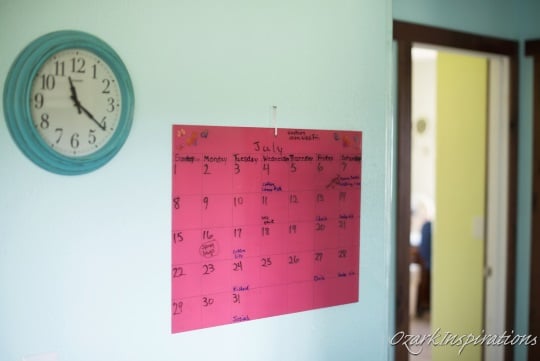
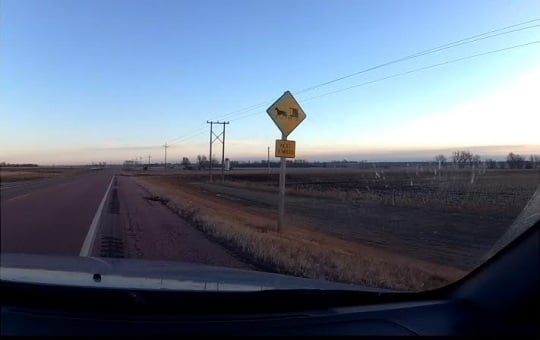


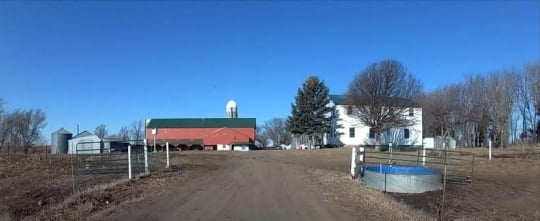
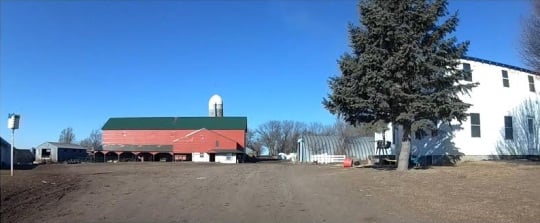
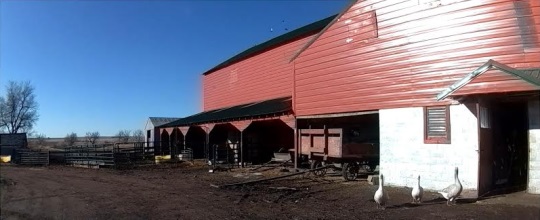





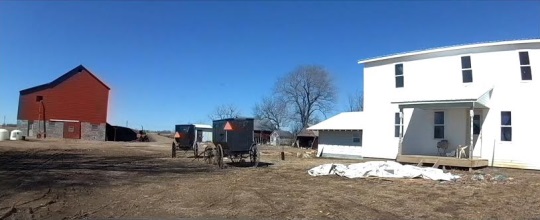
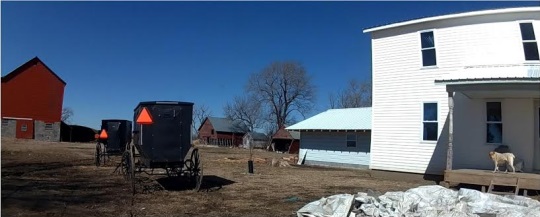
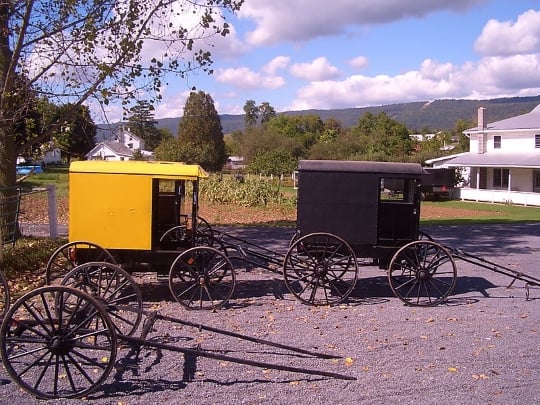
They looked like guard geese. Musch more effective.
Many years ago, we lived in a rental house in another town while our current house was being built. The kids went to school in the new town, so I had to drive them back & forth, daily(2 different schools, which started/ended at different times). There was a small house we had to pass which had a small flock of guard geese just like these—they’d sometimes stand in the middle of the road, blocking traffic and honking at us. (Thanks for the memories, Tom!)
It’s always interesting to see actual photos of an area you’re unfamiliar with…lots of open spaces to expand…no wonder the Amish chose that location.
Alice Mary
Yep
That is one of those locations where you can honestly say that when you look around what you see is nothing but miles & miles of nothing but miles & miles!
I like a prairie setting and that looks like a really good one.
I’ve come across aggressive geese at people’s homes and farms before. The local Canada Geese in the little lake/park here in Raleigh seem quite docile however. Wonder if that’s by nature or they’re just used to people around.
Aggressive geese
I don’t know the answer to your question, but individual geese can vary in aggressiveness. Back in 1995 I organized a hands-on exhibit of aquatic invertebrates for the Backyard Monsters show that was visiting Battle Creek. 20-some people volunteered to help out, but those who were collecting insects out at our experimental ponds brought back reports about being harassed by a Canada goose that made low-level strafing passes at them. Some of the stories were almost comical, about people diving for cover in the cattails at a pond’s edge, or those out in a small boat having no place to go so used a long-handled collecting net to defend themselves. But an angry goose can hurt a person, too. Our Bird Sanctuary manager with over 30-yrs experience went out to take a look and deal with it; he came back saying that was the most aggressive goose he had ever seen. This was in April which may have been nesting season – I don’t know if the same bird would have been as aggressive at other times.
When out bicycling on quiet roads in farm country, I’ve occasionally come across farm geese that think they own the road and treat me as an intruder. I do NOT stop to take pictures at those places. Some of those seemed to have been mixed flocks of more than one breed, but I couldn’t ever tell which ones were more likely to make physical contact.
Creepy or cute
It may just be me but the Canada Geese I pass while jogging seem a bit more jumpy lately. Maybe it’s breeding season and the ganders are on edge. Docile or aggressive, they are messy birds on the lake trails I run.
In other bird news I did see an owl perched in a tree yesterday around 7 pm, still a bit light out. I guess he was about due for his PM coffee.
I spent some time trying to decide whether an owl is creepy or cute. There are some animals in the category where it could go either way.
Owls are awesome Eric.. They’re one of my totem animals so of course I think they’re awesome.
I grew up around the corner from some geese… they were the very devil.. I cant tell you how many time I was chased and nipped by those devils… I dont like geese or ducks.. they got in on the action too.. meanies. 😉
Hutterites
In that county there should be some Hutterite colonies within a day’s buggy ride. I wonder if Amish and Hutterite people have any interaction.
Amish/Hutterite interaction?
I remember reading about a visit to a Hutterite community by one of the Amish contributors to Family Life. I’m going to drop Linda Maendel a note and see if she has any comment on your question John.
https://amishamerica.com/manitoba-hutterite-linda-maendel/
Amish/Hutterite Interaction
Yes, Amish and Hutterites do interact. I know Hutterites who have Amish pen pals and there has been some visiting as well. There are many Hutterite colonies in South Dakota, so it’s likely that there would be a colony or two in that county.
Amish/Hutterite Interaction
Linda, thank you for that information. And thank you, Erik, for the link to Linda’s blog.
Back in 1957, shortly after we moved to Nebraska, we visited a Hutterite colony in South Dakota. It may even have been in Hutchinson county. My father was a Lutheran pastor (yes, I know about the history of Lutherans and Anabaptists) and we had recently moved to northeast Nebraska. We’d often go out for Sunday afternoon drives, and one time it was to visit a Hutterite colony, which may have been relatively new at the time. So for a long time what I knew about Hutterites was what my father learned from talking with some of the men.
Making a curiosity visit like that may seem a weird thing to have done, but in those days there was no internet where we could learn about Hutterites, nor were there all the books and documentaries about Hutterites that one can find now. I don’t remember coming away with any strong feelings about Hutterites one way or another, just that we were a little better informed about who they are and how they lived.
I think the news about an Amish settlement will be a good excuse to call Dad tonight and ask him if that Hutterite community was in Hutchinson County. (Dad’s now 95.)
After living in Nebraska we moved to Minnesota, not too far from where my parents live now. Dad happened to be in the Wadena public library in Todd County one day when some Amish men stopped in. Amish people had never been seen in central Minnesota at that time (maybe around 1970 or so)so they were an unusual sight. Dad overheard them asking for information on the education laws for Todd County. They must have liked what they heard, because it wasn’t too much later that a settlement was started near Wadena, and the Amish community has grown quite a bit since then.
I’ll spare you the details – I could go on for many pages – but our family was quite involved in a issues of local control of our schools back when we were living in Nebraska. I have learned to have quite a bit of sympathy for groups that want to have some control over their children’s education.
You’re welcome, John! I always enjoy reading about people’s encounters with Hutterites. Stop by my blog anytime.
This is good; I like this, well done.
I think something was shared in the past that is like my idea, but I wonder if anyone has any dash-cams pictures of being in an Amish buggy.
This post reminds me of the settlement in Fertile, MN, which may be an even more remote location for Amish (where our son and his family are). I saw some news yesterday that this winter has been the coldest in 35 years for Minnesota. I bet it hasn’t been much better for this group in SD. And yesterday I checked the forecast, and found that the area where Ed lives is undergoing flooding, due to snow melt. I think his community is far enough away from the Red Lake River so they are not too effected. However, they’ve had such huge amounts of snow, that just having it melt around your home, could cause lots of problems. So we have been concerned for them and hope to hear soon that they are all ok.
I also wanted to let you know that grandson #2 was safely born in March. Caleb came on a snowy, windy night, but after less than 3 hours of labor! So we were grateful to hear that all went well. Many of you have prayed for this birth and I can’t thank you enough!
Fertile
Anne, I am surprised to learn of an Amish settlement at Fertile. I wouldn’t think the Red River valley farmland would be the kind of place where their mixed farming would work so well. But maybe the settlement is outside the valley?
I don’t think I’ve ever been to Fertile. My parents and some other family members are at Park Rapids and occasionally make trips to Fargo for medical appointments and shopping. I like wide-open prairie country, but the Red River Valley, especially on the North Dakota side, is a terrain I have not yet learned to enjoy. Wouldn’t hurt to give it another try, though.
That area had a pretty severe winter (as we did in southwest Michigan, relatively speaking) but I think as you go west you would have got out of the polar vortex and had quite a different winter experience. I just now took a quick look at accuweather.com for Parkston SD and saw that they did have some colder-than-average weather, but nothing like the sustained cold experienced by places like Park Rapids and (I presume) Fertile.
Hi John,
Our little family is near Crookston, and NE of Fargo. And I don’t know where they lie in relationship to the Red River, but would guess both rivers are part of the same system. And it was Crookston that was flooding, though I’ve no recent news. The town is named for its soil, “fertile”! It’s truly dark, rich stuff and I can’t believe what they can grow in their shorter growing season. Never seen pumpkins as large as what they grow! The terrain is fairly flat, but has some variation, though few trees. And nearby by is a sand flat, that seems to somehow connect with the fertility of this region.
We're going to be near Fertile, MN this fall
Anne, I was so glad to see you post — and congratulations on the new grandson! We’re going to my niece’s wedding in the next county north of Fertile this September; I would love to talk to you privately about possibly visiting them while we’re there, since we’re planning to stay in the area for over a week. It would be fun to meet this little family that you and your husband have shared a bit about here.
Eric, is there any way you could pass my email privately on to Anne?
Sure can Laura. Just sent it to Anne.
Just reading all this; don’t know how I missed it earlier. Congratulations to Anne on new baby, and hoping for a beautiful spring and summer in Minnesota. What is a dash cam? And Erik, owls are very cool.
Dash Cams
Tom can tell you more, but a dash cam is just a camera mounted on the dashboard which I think is typically always recording the area in front of the vehicle.
On a related note, dash cams are apparently very popular in Russia as a sort of insurance policy to protect against police corruption, hit and runs and other road incidents. I don’t think Russia is the best place to be a driver.
http://www.businessinsider.com/why-russian-drivers-have-dash-cams-2012-12
And ‘hoo’ knows, owls might just be my new favorite bird.
Adair,
Erik was right on.
Have you ever been out driving and saw something and wished you would have had a camera in your hand at the time to take a picture of it? Most of the time even if you had a camera setting next to you, by the time you grabbed it, whatever it was you saw is gone. (and it’s not safe to drive with one hand and try to take pics with the other. Plus those pictures will probably come out fuzzy)
That’s what the dash cam is good. You set it and forget it.
Though we refer to it as a ‘dash’ cam mine hooks to the front window. It doesn’t block me from seeing the road or other things. You plug it into your cars cigarette lighter or a USB power plug in if your car is newer. It comes on when you start up the car and off when you shut the car off. The memory card will hold about 5+ hours of video before it starts over writing onto what was already recorded.
Once you have a video you like you can move it to your computer to watch later on. They record in 5 minute segments. You can take a video, freeze it, and than make an individual picture out of it. That’s the pictures you see me post for the most part.
TMI? (Too Much Information? Sorry? Not enough information? Thank check this site out.
http://dashcamtalk.com/dr32/#User_Manual
My friend, that got me hooked up with this dashcam, wants me to remind you that my cam is now a year plus old and better ones might be out there. This one takes some pretty sharp videos.
Tom in Lincoln LincNebr@hotmail.com
Well thanks for the info! Sounds pretty high-tech. I actually do usually have a camera at hand, but you are right that often whatever I want the photo of has gone by the time I get the camera out. Hate to admit it but I have indeed been guilty of driving with one hand and shooting a photo with the other (not often) – usually the photos are terrible but occasionally they’re good!
Amish/Hutterite interaction.
Canistota , South Dakota is a Mecca for Amish . They travel from all over the US and Canada to come to the Ortman Clinic. Usually they plan to take a series of treatments for a week. Many will visit Hutterite colonies within an hour’s drive of Canistota so there’s been that interaction for decades. Some Hutterites subscribe to the Sugarcreek Budget and most colonies would get the Pathway publications.
Hutchinson County South Dakota now has the distinction of being the only county in the US with a Amish, Mennonites and Hutterites. The Mennonites and Hutterites have been here since the 1870’s and Hutchinson County would have the largest concentrations of both groups in the state though there are some sixty colonies of Hutterites in SD. Five of these colonies are in Hutchinson County though the colonies closest to Tripp are in neighboring Douglas County, Greenwood colony. I know the Greenwood Colony invited the Amish over for a day of visitation and the line of buggies were seen going down the road to Greenwood.
In fact, much of the land that the Amish here at Tripp are living on was once owned by Hutterites in the late 1800’s but they abandoned the area there north of Tripp because of lack of water. It’s very difficult to get a well in that area so the Tripp, SD Amish have made a compromise and they are hooked up to rural water.
To some it seems a contradiction that most AMish ministers will site II Cor. 6:14 when asked about their opposition to electricity. That passage says: “Be not unequally yoked together with nonbelievers . . .” They then explain that the electric line that runs into their yard would run also into the farm of a nonbelieving neighbor. When asked why this principle does not also apply to rural water, you’re met with silence.
The Hutterites readily embrace technology and oppose use of TV, radio, musical instruments and internet usage in the homes. Many colonies oppose internet altogether but they have the finest equipment for farming and business that they can have.
The Hutterite presence in SD may make it difficult for Amish to capitalize on certain businesses like raising veggies, chickens, etc. as not only does SD have a sparse population but the Hutterites are involved in many of these same enterprises and they can raise things in a big way and cheaper than most.
The Amish have met with South Dakota’s strange weather which has bested many people and have left us with a sparse population. They had hail one year, a complete crop failure one year, then a very good year, and last year they had some hail damage again. There may be a reason Amish never tried SD before. THe Hutterites and Mennonites that have successfully lived here for 140 years came from Ukraine so they were already used to the harsh climate.
Oh, and note to Tom Geist. You’re not a farm kid are you? The white “containers” as you call them are polydome calf huts. They’re not containers but are built with the express purpose of housing a baby calf. If you’d gotten a picture going west from Rudy’s the place with the store, there are dozens upon dozens in a row.
Nice post Lee. I knew SD was the biggest Hutterite state but didn’t realize there were so many colonies in the same area and even county. I’m glad you pointed out the contrast in Amish and larger-scale Hutterite farming methods. If they do find themselves competing with Hutterite produce, maybe they could gain an edge via marketing and the appeal of “Amish-made” 🙂
Interesting response (or non-response) from the Amish ministers on being hooked up to rural water vs. rejecting public power. From a visual symbolic standpoint, water connections are basically invisible vs. power lines which are often not. Beyond that, there are of course other reasons to be against having public power, most important of which is that it invites disruptive technology, while public water does no such thing.
Amish and Hutterite Roots
I am fascinated by the S. Dakota settlement of Amish in Hutchinson County, my old home. Their interaction with the Hutterites is also something good to learn about. By the way of introduction, my heritage is “Pennsylvania Dutch”/Amish, but my forefathers left Lancaster for South Dakota over a century ago, settling in the Mennonite community of Menno-Freeman where I grew up. Although I was aware of our heritage, my family was not affiliated with any church: Amish, Mennonite or Hutterite. As a seeking young person I enjoyed the fellowship of the young people at our neighbor Hutterite colony, Wolf Creek, and got to know many Hutterite colonies in the process, and eventually “joined” the Forest River Colony in North Dakota as a member of the “novitiate”, the stage of membership before taking final vows, where I remained for several years. When the evangelical Hutterite Youth Movement with an emphasis on “new birth” came through our colony I was among those caught up in the new visitation, which was rejected by many old order Hutterites. I was a part of the new beginning in Manitoba where an independent Hutterite-like colony was established, made up of ex-Hutterites and many new converts from “outside”, including Blacks and Native Indians, all dressed in Hutterite garb. There at Bethesda Colony I was elected as one of the ministers and served in that capacity for many years. Although very Hutterite-like, at that stage we were recognized as a “Church Community” of the Mennonite Church. The “colony” later gave up community of “goods” and reorganized into non-communal, mutual aid-type congregations, of which I am still a part, which functions under the auspices of Global Missions Inc. We have an excellent relationship today with the colonies and many of the leading ministers. I was sent overseas by the community, along with my wife, as a missionary to the West Indies where we established 11 new congregations. We returned to Hutchinson County in South Dakota a few years later. I taught “Hutterite Studies” at Freeman College, a Mennonite college (now Freeman Academy). I also ran for the Legislature and was elected to two terms as a member of the House of Representatives, with strong voting support from both the Mennonite and Hutterite communities. We are now back in Manitoba with the congregations that were initially an outgrowth of the Hutterite Youth Movement. I would welcome email correspondence if anyone would like to know more. Email me at: diakonos.travelling@gmail.com
Minister Miller, you say you are fascinated by the Amish in Hutchinson County, but reading this I’d say you’ve lived a fascinating life too.
One of this website’s friends, Linda Maendel, who lives in a Manitoba Hutterite colony, will be sharing posts on Hutterite life in the coming weeks/months, and I hope you’ll feel free to chime in.
Hopefully we’ll hear more at some point on this SD Amish community as well.
A good story. Perhaps you could give more details someday.